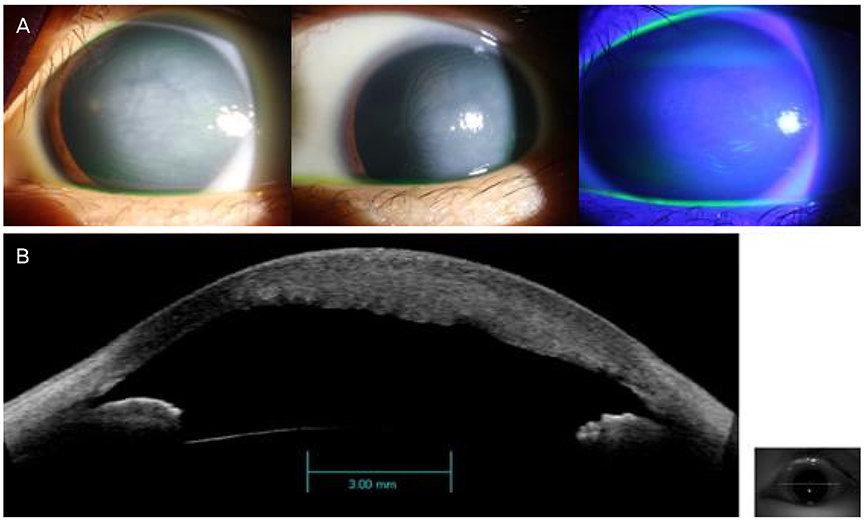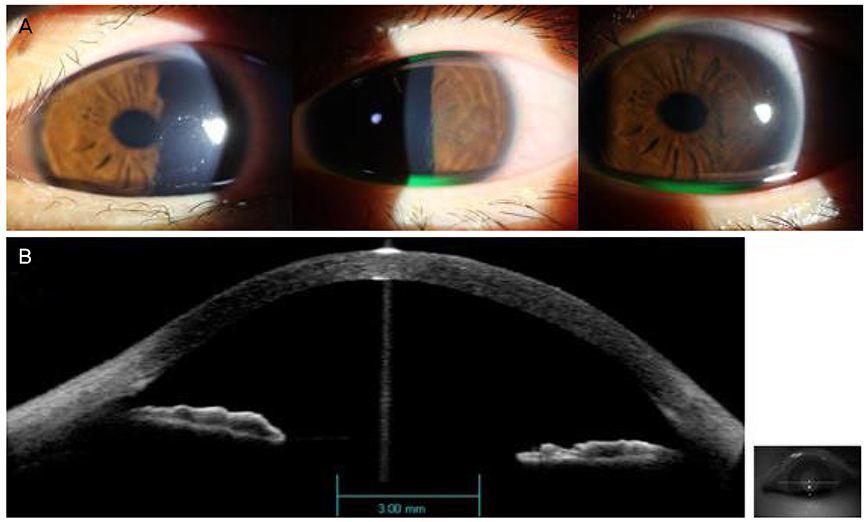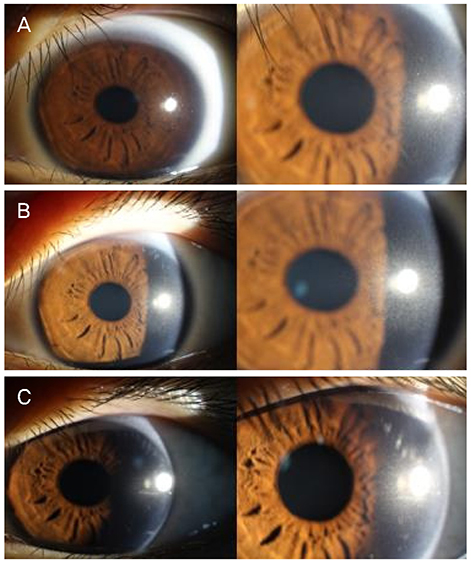J Korean Ophthalmol Soc.
2019 Oct;60(10):994-998. 10.3341/jkos.2019.60.10.994.
Corneal Stromal Edema during Lidocaine Injection for Blepharoplasty
- Affiliations
-
- 1Hangil Eye Hospital, Incheon, Korea. alive1120@naver.com
- KMID: 2460519
- DOI: http://doi.org/10.3341/jkos.2019.60.10.994
Abstract
- PURPOSE
To report a case of corneal edema caused by an iatrogenic lidocaine injection into the corneal stroma created while performing a local anesthetic (lidocaine) injection into the eyelid for a blepharoplasty procedure.
CASE SUMMARY
A 15-year-old female visited our clinic after the onset of severe pain and decreased visual acuity while receiving a local anesthetic injection in the upper blepharon for a blepharoplasty procedure. At the first clinical visit, visual acuity was hand motion and an accurate anterior chamber examination was difficult because of corneal edema. The Seidel test was negative. On corneal optical coherence tomography, the corneal thickness was 1,580 µm without any sign of Descemet's membrane detachment. We prescribed 5% NaCl four times a day and prednisolone acetate eight times a day. On the next day after injury, the corneal edema was significantly improved (central corneal thickness: 660 µm), and Descemet's membrane detachment was still not observed. One week after injury, the naïve visual acuity was 20/20, the central corneal thickness was 560 µm, and the endothelial cell count was 3,260 cells/cm². Three weeks after injury, the corneal edema was fully resolved and only slight temporal corneal haziness remained. After 2 months, the cornea was clear without any subjective discomfort.
CONCLUSIONS
Corneal edema without Descemet's membrane detachment can be resolved spontaneously without aggressive treatment such as gas or air injection. However, endothelial cell count and corneal opacity need to be monitored on follow up exam. This clinical experience suggests that severe corneal edema in anterior stromal layer could be spontaneously resolved without severe complication.
Keyword
MeSH Terms
Figure
Reference
-
1. Kim BR, Park SY, Lee HK, et al. A case of Descemet's membrane detachment during lidocaine injection for hordeolum incision and drainage. J Korean Ophthalmol Soc. 2016; 57:1790–1794.
Article2. Schellini SA, Creppe MC, Gregório EA, Padovani CR. Lidocaine effects on corneal endothelial cell ultrastructure. Vet Ophthalmol. 2007; 10:239–244.
Article3. Rosenwasser GO. Complications of topical ocular anesthetics. Int Ophthalmol Clin. 1989; 29:153–158.
Article4. Britton B, Hervey R, Kasten K, et al. Intraocular irritation evaluation of benzalkonium chloride in rabbits. Ophthalmic Surg. 1976; 7:46–55.
Article5. Ghosh S, Mukhopadhyay S, Mukhopadhyay S, et al. Inadvertent intracorneal injection of local anesthetic during lid surgery. Cornea. 2010; 29:701–702.
Article6. Eggeling P, Pleyer U, Hartmann C, Rieck PW. Corneal endothelial toxicity of different lidocaine concentrations. J Cataract Refract Surg. 2000; 26:1403–1408.
Article7. Heuermann T, Hartmann C, Anders N. Long-term endothelial cell loss after phacoemulsification: peribulbar anesthesia versus intracameral lidocaine 1%: prospective randomized clinical trial. J Cataract Refract Surg. 2002; 28:639–643.8. Chuang LH, Yeung L, Ku WC, et al. Safety and efficacy of topical anesthesia combined with a lower concentration of intracameral lidocaine in phacoemulsification: paired human eye study. J Cataract Refract Surg. 2007; 33:293–296.9. Ezra DG, Allan BD. Topical anaesthesia alone versus topical anaesthesia with intracameral lidocaine for phacoemulsification. Cochrane Database Syst Rev. 2007; 18. CD005276.
Article
- Full Text Links
- Actions
-
Cited
- CITED
-
- Close
- Share
- Similar articles
-
- The Therapeutic Effects of Early Administration of 5%Na Cl Eye Drops on Corneal Edema Induced by Intracameral Injection of 2%Lidocaine in Rabbits
- The Instillation Interval of 5% NaCl Eye Drops to Treat Corneal Edema in Rabbit
- Interactions of Corneal Endothelial Cells with Stromal Cells during Corneal Endothelial Injury
- The Effects of Unpreserved Lidocaine on the Corneal Endothelium during Cataract Surgery
- A Case of Descemet's Membrane Detachment during Lidocaine Injection for Hordeolum Incision and Drainage




